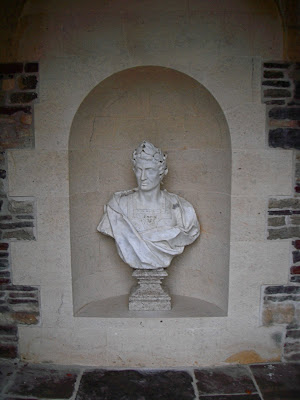
Jacqueline asked if the head (in the post over on my Lifestyle blog) was a self-portrait. On the face of it, that would seem to be an irrelevant question, but - in fact - it's a very good one.
I was using a friend's digital camera (what camera's aren't digital these days?), to photograph the marble bust in the picture above, which I have just finished restoring by re-polishing, etc. (it was green with algae and weather-worn) and making the stone 'socle' or plinth for it, before taking it to the niche where it will now live. The camera was set to 'auto' mode, and as I depressed the shutter button, a little green square appeared in the view-finder, neatly framing the austere face of Julius Caesar. Yes, the camera had recognised the lump of hewn marble as a human face, and had been programmed to focus on it to the exclusion of all else. Presumably it was also trained to eradicate any 'red eye' that might occur if J.C. happened to come alive after about 200 years of being trapped in white marble, and stare directly into the camera lense.
People usually ask "What would happen if you take too much stone away?" when carving an expensive bit of portraiture, to which I reply that most people do not take enough away, so the opposite is the biggest danger. After you have knocked the corners off a block, it is very difficult to know exactly where you are inside it, without resorting to a laborious 'pointing' system, which is better suited to copy-carving, where originality has to be avoided. For this reason, there are many figurative sculptures around the world, in which you can still see the ghost corners from the original block.
Then they ask, "What happens if you accidentally knock the nose off at the last minute?" to which I reply that you are rarely using enough force to do that during the last stages of carving, and if I did, I would stick it back on again.
Jacqueline asked, "Is the head a self portrait?" to which I replied 'Only the nose'. It just so happens that my nose is well suited to use as a model for a dirty old man's, leering threateningly out of the bushes in someone's garden, so I that's what I did.
Partly because of the disappearing corners business, and partly because - for some reason - we seem to forget where the nose is placed on the face, how many nostrils it has, whether it is above or below the mouth, etc. we need to refer to other nose when creating one from scratch. Why this is the case, I have no idea, other than that we imbue other qualities into 'noseness' which go far beyond the simple functionality of breathing, or smelling a rose. Considering how many times we stare into someone else's face, or look into a mirror every day, you would think we knew all about noses, but we don't. We need to refer to yet another nose directly, when modeling or carving one from scratch. Usually, the nearest face to us at the time is our own, so if you happen to have a feature which could be adapted to suit the purpose, then you hang up a mirror, then peer into it every few minutes to see where you are going wrong. Pictures or 2 dimensional, photographic images do not help. They hardly contain any information at all, other than to remind you that the nose is - indeed - above the mouth (I had to think about that one), which is the limit of that clever camera's face-recognition system.
The guy who helped me carve that big head is a brilliant sculptor, and he has a nice nose too, but it is not the nose needed for the Old Man's, it has to be said. I left him alone with the carving whilst I went to lunch one day, with the strict (or what I thought to be strict) instructions to concentrate on the hair and beard - not the flesh. When I returned, he was busy altering the nose, using his own as an example by looking into the nearby mirror and chopping away at the stone with a sharp chisel. I just stopped him in time - almost.
So you see, it is extremely difficult not to turn every figurative sculpture into a self-portrait.
Sincere carving. Sans cire (fr). Sine cire (L). Waxless noses (or other bits)....
ReplyDeleteOnce again, I thank you without wax for that tit-bit, Cro.
ReplyDeleteIn art classes long long ago, the teacher told us that she'd noticed that people, despite themselves, always made papier maché puppets in their own image. I looked around and it was conspicuously true. What we need is a stone head identity parade for us to have a go at selecting yours.
ReplyDeleteLiving on the inside of our faces as we do Tom, I was curious about the artists approach to creating one.
ReplyDeleteWe never actually 'see' our own faces as others do. We see it in pictures, which as you state are short on information, or we see the whole arrangement reversed in a mirror.
My best friend claims to know me well because she lives on 'the outside of my face'.
I'm often surprised when I catch my reflection in a mirror to see how sternly I frown.
Interesting blog that Tom. Looking back to the Lifestyle post, The Old Man's nose is a dead ringer! It's good!
ReplyDeleteDead ringer for what, Moll? (don't be filthy - you know I hate filth)
ReplyDeleteHey you! My only interpretation of 'dead ringer' is something or someone identical. I didn't know there was any other sort. Moll.
ReplyDelete